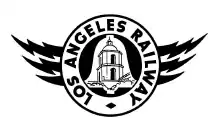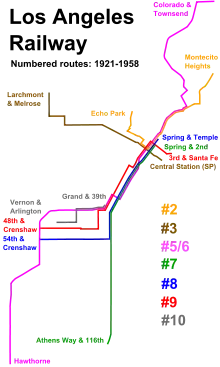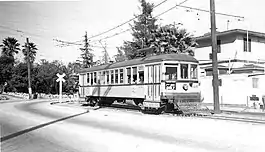Los Angeles Railway
The Los Angeles Railway (also known as Yellow Cars, LARy and later Los Angeles Transit Lines) was a system of streetcars that operated in Central Los Angeles and surrounding neighborhoods between 1895 and 1969. The system provided frequent local services which complimented the Pacific Electric "Red Car" system's largely commuter-based interurban routes. The company carried many more passengers than the Red Cars, which served a larger and sparser area of Los Angeles.
 | |||
| Overview | |||
|---|---|---|---|
| Locale | Los Angeles, California and its suburbs | ||
| Transit type | Streetcar | ||
| Number of lines | 25 | ||
| Operation | |||
| Began operation | 1895 | ||
| Ended operation | 1969 | ||
| Operator(s) | Los Angeles Railway | ||
| Reporting marks | LARy | ||
| Technical | |||
| Track gauge | 3 ft 6 in (1,067 mm) | ||
| Electrification | 600 V DC overhead line[1] | ||
| |||
Cars operated on 3 ft 6 in (1,067 mm) narrow gauge tracks,[2] and shared dual gauge trackage with the 4 ft 8 1⁄2 in (1,435 mm) standard gauge Pacific Electric system on Main Street in downtown Los Angeles (directly in front of the 6th and Main terminal), on 4th Street, and along Hawthorne Boulevard south of Downtown Los Angeles toward the cities of Hawthorne, Gardena and Torrance.
History
Predecessor: The Los Angeles Consolidated Electric Railroad Company
The first electric railway in Los Angeles was built in 1887 to facilitate the sales of a real estate tract on Pico Street. The Los Angeles Electric Railway used the early Daft overhead system and used a crude electric car and trailers. Though the real estate venture was successful, after an explosion in the power station, the Pico Street electric line closed, seemingly for good. Los Angeles also had significant investments in cable technology. The Los Angeles Cable Railway (later named the Pacific Cable Railway) owned many exclusive franchises agreements to city streets and had constructed several major cable lines crisscrossing the growing downtown area, considered the latest word in cable railway technology.[3] But construction was expensive, legal and operating problems plagued the system, and new technological developments threatened to make the system obsolete.
Development of an effective electric transportation system based on the new Sprague-based technology began in earnest with the arrival in Los Angeles of Moses Sherman, his brother-in-law Eli P. Clark and San Francisco investors late in 1890. Sherman, originally a teacher from Vermont, had moved to the Arizona territory in 1874 where he was involved in business and civic affairs, real estate, and street railways.[4]
Sherman became interested in opportunities in Los Angeles after vacationing there in early 1890. He joined the efforts of a group attempting to resurrect the Second Street Cable Railway, but persuaded them to electrify the line instead. He acquired the line in October, 1890 and renamed it The Belt Line Railroad Company.[3]
Sherman created an Arizona corporation called the Los Angeles Consolidated Electric Railway Company (LACE) on November 12, 1890 with Sherman as President, Clark became General Manager. Fred Eaton was the Chief Engineer. Incorporating in Arizona was chosen because it had certain advantages over California incorporation.[5] In the fall of 1890, the so-called 5-block law was passed, which enabled a street railway company to use another companies rails for up to five city blocks. This would help Sherman immensely with his plans for LACE.[3]
Sherman and Clark began work immediately. In 1891 alone, they accomplished the following:[6][3]
- Purchased the Depot Line on May 8, which ran from Second and Spring Streets to the Santa Fe Depot and to the Southern Pacific depot.
- Opened a line on First Street line to Westlake Park on July 1, replacing the Second Street Cable line.
- Acquired the Los Angeles and Vernon Street Railway, whose line ran down Central Avenue, and opened it as an electric line on September 16.
- Built a new line to serve the University of Southern California and Agricultural Park; the University line opened November 12.
- Opened the Maple Avenue Line in November.
- Opened the newly rebuilt and re-electrified Pico Street line on December 31.
Pacific Railway’s problems were such that the company was thrown into receivership in 1891, with James F. Crank appointed as receiver.[3]

In 1892, they electrified the Depot Line, and opened it on August 1.
They also started a line up North Spring and North Broadway Streets, but were forced to build a bridge over the Los Angeles River and Santa Fe rails, which postponed the opening of the line to East Los Angeles (Eastlake Park) until September 26, 1893.[4]
The growth of the electric lines put severe pressure on the Pacific Cable Railway, which also faced other difficulties. The two rail companies began negotiations to possibly combine in August, 1892.[3] On October 4, 1893, the sale of the Pacific Cable Railway was completed, and LACE acquired all of the assets, including their cable and horsecar lines.[7] LACE was now the largest street railway operator in Los Angeles, owning about 90% of all lines.[8]
In 1894, Sherman and Clark began an inter-urban line between LA and Pasadena, The Los Angeles and Pasadena Railway, and acquired all the street railways in Pasadena.[8] But in 1895, Sherman and Clark faced difficulties themselves. In April, 1894 LACE missed a scheduled bond payment.[9] The bondholders, unhappy with Sherman and Clark management and their attention to their new interurban railway, secured control of the company. Sherman managed to retain 49% of the outstanding stock, but he and Clark no longer had any management responsibilities.[10] The bondholders created a new corporation called the Los Angeles Railway (LARy) and March 23, 1895 LARy acquired all of LACE’s assets, except for the Los Angeles and Pacific Railway and the Pasadena street railways. [4][8]
The new management purchased new cars began converting all the existing horsecar and cable lines to electricity, a task completed by June, 1896.[4]

The system was purchased by railroad and real estate tycoon Henry E. Huntington in 1898. At its height, the system contained over 20 streetcar lines and 1,250 trolleys, most running through the core of Los Angeles and serving such neighborhoods as Crenshaw, West Adams, Leimert Park, Exposition Park, Echo Park, Westlake, Hancock Park, Vernon, Boyle Heights and Lincoln Heights.

Decline
%252C_1942.jpg.webp)
The system was sold in 1944 by Huntington's estate to American City Lines, Inc., of Chicago, a subsidiary of National City Lines, a holding company that was purchasing transit systems across the country.[11] The sale was announced December 5, 1944, but the purchase price was not disclosed.[12] National City Lines, along with its investors that included Firestone Tire, Standard Oil of California (now Chevron Corporation) and General Motors, were later convicted of conspiring to monopolize the sale of buses and related products to local transit companies controlled by National City Lines and other companies[n 1] in what became known as the General Motors streetcar conspiracy. National City Lines purchased Key System, which operated streetcars systems in Northern California, the following year.
The company was renamed as Los Angeles Transit Lines.[13] The new company introduced 40 new ACF-Brill trolley buses which had originally been intended for the Key System streetcar system in Oakland which was being converted by National City Lines to buses in late 1948.
Many lines were converted to buses in the late 1940s and early 1950s.[13]
Public ownership and finale
The last remaining lines were taken over by the Los Angeles Metropolitan Transit Authority (a predecessor to the current agency, The Los Angeles County Metropolitan Transportation Authority (Metro)) along with the remains of the Pacific Electric Railway in 1958. The agency removed the remaining five streetcar lines (J, P, R, S and V) and two trolley bus lines (2 and 3), replacing electric service with diesel buses in March 31st, 1963.[14]
List of routes

- A Line – Mid City to Echo Park; by way of Adams Boulevard, Kensington Street, Venice Boulevard, Broadway, Temple Street, Edgeware Road, and Douglas Street.
- B Line – Nevin to City Terrace; by way of Ascot Avenue, Hooper Avenue, 12th Street, Main Street, Brooklyn Avenue, Evergreen Avenue, Wabash Avenue, and City Terrace Drive.
- D Line – Westlake to Skid Row; by way of Bonnie Brae Street, 3rd Street, Alvarado Street, 6th Street, and 5th Street.
- F Line – Athens to Boyle Heights; by way of Vermont Avenue, Hoover Street, Santa Barbara Avenue, Grand Avenue, Jefferson Boulevard, Main Street, 3rd Street, 4th Place, 4th Street, and Fresno Street.
- G Line – Nevin to South Park; by way of McKinley Avenue, Jefferson Boulevard, Griffith Avenue, Washington Boulevard, and Main Street.
- H Line – South Los Angeles to East Hollywood; by way of San Pedro Street, 7th Street, Broadway, 6th Street, Rampart Boulevard, Beverly Boulevard, Heliotrope Drive, and Melrose Avenue.
- I Line -

- J Line – Jefferson Park to Huntington Park; by way of Jefferson Boulevard, Central Avenue, Vernon Avenue, and Pacific Boulevard.
- K Line -
 Nevin to South Park; by way of Naomi Avenue and Olympic Boulevard.
Nevin to South Park; by way of Naomi Avenue and Olympic Boulevard. - L Line – East Hollywood to Mid-City; by way of Lexington Avenue, Madison Avenue, Temple Street, Broadway, and Olympic Boulevard.
- N Line – Koreatown to South Park; by way of 8th Street and 9th Street.
- O Line – South Los Angeles to Lincoln Heights; by way of Main Street.
- P Line – Mid-City to City Terrace; by way of Pico Boulevard, Main Street, 1st Street, Gage Avenue, Hammel Street, and Record Avenue.
- R Line – Hancock Park to East Los Angeles; by way of 3rd Street, Vermont Avenue, 7th Street, Boyle Avenue, and Whittier Boulevard.
- S Line – Watts to East Hollywood; by way of Central Avenue, Florence Avenue, Avalon Boulevard, Vernon Avenue, Vermont Street, 3rd Street, and Western Avenue.
- U Line – Nevin to West Adams; by way of Central Avenue, Jefferson Boulevard, Vermont Street, and 27th Street.
- V Line – Nevin to East Hollywood; by way of Santa Fe Avenue, 7th Street, and Vermont Street.
- W Line – Mid-City to Highland Park; by way of Washington Boulevard, Figueroa Street, 6th Street, Broadway, Avenue 20, Figueroa Street, and York Boulevard.
- 2 Line – Rampart area of Echo Park to Montecito Heights; by way of Belmont Avenue, Loma Drive, 3rd Street, Flower Street, 5th Street, Broadway, Pasadena Avenue, Avenue 26, and Griffin Avenue.
- 3 Line – Skid Row to Hollywood; by way of 5th Street, 6th Street, private ROW, 3rd Street, and Larchmont Boulevard.
- 5 Line – Hawthorne to Eagle Rock; by way of Hawthorne Boulevard, Market Street (Inglewood), private ROW paralleling Redondo Boulevard (later Florence Avenue), Crenshaw Boulevard, Leimert Boulevard (dedicated tracks in center divider), Santa Barbara Avenue, Grand Avenue, Jefferson Boulevard, Main Street, Broadway, Pasadena Avenue, Avenue 20, Figueroa Street, Cypress Avenue, Eagle Rock Boulevard, and Colorado Boulevard.
- 7 Line – South Los Angeles to Los Angeles Plaza Historic District; by way of Broadway, Main Street, and Spring Street.
- 8 Line – Leimert Park to Los Angeles Plaza Historic District; by way of 54th Street, Broadway, Main Street, and Spring Street.
- 9 Line – Leimert Park to the Wholesale District, by way of 48th Street, Hoover Street, Grand Avenue, Pico Boulevard, Broadway, and 2nd Street.
- 10 Line – Leimert Park to Lincoln Heights; by way of Vernon Avenue, Dalton Avenue, Martin Luther King Boulevard, Grand, Pico Boulevard, Broadway, and Lincoln Park Avenue.
Rolling stock

Beginning in 1937, Los Angeles Railway began purchasing PCC streetcars to replace the old rolling stock on lines which were too popular to convert to bus operations.[15]
Many cars were simply scrapped after service ended. In 1956, 41 Type H-4 cars were sent to Seoul and Pusan, South Korea as part of an aid program.[1]
Livery
The railway was well known for its distinctive yellow streetcars.[15][16] Initially cars had a two-tone yellow paint scheme with a lighter shade for the roof.[16] Under NCL the three color "fruit salad" scheme was adopted, with a yellow body and white roof with a seafoam green midsection.[15]
 Los Angeles Railway livery
Los Angeles Railway livery Los Angeles Transit Lines livery
Los Angeles Transit Lines livery
See also
- Angels Flight, funicular railway
- Historic Downtown Los Angeles Streetcar, proposed restoration of some streetcar service
- Los Angeles Pacific Railroad
- List of funicular railways
- San Diego Electric Railway
- Southern California Rapid Transit District
- Streetcars in Los Angeles
References
- Walker, Jim (2007). Los Angeles Railway Yellow Cars. Arcadia Publishing Library Editions. ISBN 978-1531629410.
- "The Street Railway Journal". McGraw. April 9, 1904. Retrieved 19 September 2020.
- Swett 1951, p. 35.
- Post 1989, p. 29.
- Post 1989, p. 105.
- Swett 1962, p. 3.
- Post 1989, p. 120.
- Swett 1951, p. 36.
- Post 1989, p. 128.
- Post 1989, p. 129.
- "Finding Aid for the Los Angeles Railway Corporation Legal Records and Correspondence".
the controlling interest remained part of the Huntington estate until 1945 when the Fitzgerald Brothers purchased those shares. LARy became part of the National City Lines, was renamed the Los Angeles Transit Lines, and eventually the streetcars were phased out, replaced by motor buses.
- Associated Press, “Chicago Firm Buys L. A. Streetcar Line”, The San Bernardino Daily Sun, San Bernardino, California, Wednesday 6 December 1944, Volume 51, page 5.
- "Book Review: Los Angeles Railway Yellow Cars". Archived from the original on 2013-08-13. Retrieved 2010-10-26.
By the end of World War II, the Huntington estate sold its majority interest to Chicago-based National City Lines. LARY became the Los Angeles Transit Lines, and bigger changes were in store. Many lines were converted to bus operation through the late forties and fifties. Never mind that NCL was partially owned by bus, tire, and gasoline suppliers. Though Federal antitrust action was taken against NCL, the damage was already done. Los Angeles was officially in love with the automobile.
- https://untappedcities.com/2013/02/04/la-yellow-car-vintage-photos/
- "No.1080 Los Angeles Transit Lines". Market Street Railway. Retrieved 23 January 2021.
- "No.1052 Los Angeles Railway". Market Street Railway. Retrieved 23 January 2021.
Further reading
- Bottles, Scott (1991). Los Angeles and the Automobile: The Making of the Modern City. University of California Press. ISBN 0-520-07395-9.
- Copeland, P. Allen (2002). California Trolleys In Color, Volume 1: San Diego and Los Angeles. Scotch Plains, NJ: Morning Sun Books, Inc. ISBN 1-58248-076-1.
- Easlon, Steven L. (1973). Los Angeles Railway Through the Years. Anaheim, CA: Easlon Publications.
- Fogelson, Robert (1967). The Fragmented Metropolis Los Angeles: 1850-1930. Cambridge, Massachusetts: Harvard University Press.
- Freidricks, William B. (1992). Henry Huntington and the Creation of Southern California. Columbus, OH.: Ohio University Press. ISBN 0-8142-0553-4.
- Hendricks, William O. (1971). Moses Sherman: A Pioneer Developer of the Pacific Southwest. Corona Del Mar, CA: The Sherman Foundation.
- Longstreth, Richard (1997). City Center to Regional Mall: Architecture, the Automobile, and Retailing in Los Angeles, 1920-1950. Cambridge, Massachusetts: MIT Press.
- Moreau, Jeffrey (1964). The Los Angeles Railway Pictorial. Los Angeles, CA: Pacific Bookwork.
- Perry, Louis B. & Richard S Perry (1963). A History of the Los Angeles Labor Movement, 1911-1941. Berkeley and Los Angeles, CA: University of California Press.
- Post, Robert C. (September 1970). "The Fair Fare Fight: An Episode in Los Angeles History". Southern California Quarterly. Historical Society of Southern California. 52 (3): 275–298. doi:10.2307/41170300. JSTOR 41170300.
- Post, Robert C. (1989). Street Railways and the Growth of Los Angeles. San Marino, CA: Golden West Books. ISBN 0-87095-104-1.
- Sitton, Tom (2005). Los Angeles Transformed: Fletcher Bowron's Urban Reform Revival, 1938-1953. Albuquerque, NM: University of New Mexico Press.
- Sitton, Tom (1992). John Randolph Haynes; California Progressive. Stanford, CA: Stanford University Press.
- Squier, Gerald (October 2013). "Los Angeles Railway". Motor Coach Age. Motor Bus Society.
- Squier, Gerald (January 2015). "Los Angeles Transit Lines". Motor Coach Age. Motor Bus Society.
- Stimson, Grace Heliman (1955). Rise of the Labor Movement in Los Angeles. Berkeley, CA: University of California Press.
- Swett, Ira (1951). Los Angeles Railway; Interurbans Special #11. Los Angeles, CA: Interurban Press.
- Swett, Ira (1952). Los Angeles Railway All-time Roster; Interurbans Special #12. Los Angeles, CA: Interurban Press.
- Swett, Ira (1962). Los Angeles Railway Pre-Huntington Cars 1890-1902; Interurbans Special #22. Los Angeles, CA: Interurban Press.
- Swett, Ira (1964). Die Day In LA; Interurbans Special #35. Los Angeles, CA: Interurban Press.
- Thorpe, James (1994). Henry Edwards Huntington: A Biography. Berkeley, CA: University of California Press.
- Walker, Jim (1977). The Yellow Cars of Los Angeles. Glendale, CA: Interurban Press. ISBN 0-916374-25-4.
- Walker, Jim (2007). Images of Rail Series: Los Angeles Railway Yellow Cars. Charleston, SC: Arcadia Publishing.
- Wilson, Jane (1990). Gibson, Dunn & Crutcher, Lawyers: An Early History. Torrance, CA: Gibson, Dunn & Crutcher.
External links
| Wikimedia Commons has media related to Los Angeles Railway. |
- Restoration of Historic Streetcar Service in Downtown Los Angeles Current MTA efforts to restore the streetcars downtown
- goLAstreetcar An initiative to bring streetcar services back to downtown Los Angeles
- Los Angeles Railway gallery by Metro Transportation Library and Archive
- Los Angeles Transit Lines Training Film From YouTube
- Orange Empire Railway Museum official website
- wetzel/pery.htm Tours in a Bygone Era
- Electric Railway Historical Society list of ninety seven Ira Swett Interurban Press releases, including coverage of Los Angeles Railway.
.svg.png.webp)